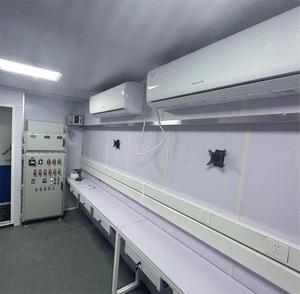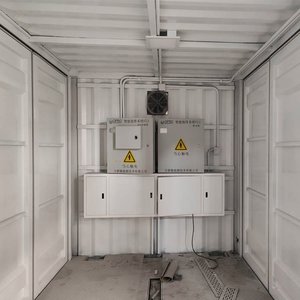
All categories
Featured selections
Trade Assurance
Buyer Central
Help Center
Get the app
Become a supplier

(3273 products available)










































There are various types of temporary construction camps based on their configuration and purpose. Here is a breakdown:
Modular Temporary Construction Camps
Modular temporary construction camps consist of pre-built modules transported to the site and assembled. These modules are designed for accommodation, dining, offices, restrooms, and storage. They offer flexibility since additional modules can be added to increase space and facilities. The company can customize the modules to fit specific requirements and include amenities such as internet connectivity, HVAC systems, and kitchen appliances.
Container-Based Temporary Construction Camps
A container-based temporary construction camp is built using shipping containers repurposed for onsite use. The containers are modified to function as living quarters, offices, kitchens, or storage spaces. The containers are durable and provide enhanced security because of their strong steel construction. They are also easy to transport and relocate because of their standardized size and design. This type of construction camp is suitable for remote locations with limited infrastructure.
Tent-Style Temporary Construction Camps
Tent-style camps use heavy-duty fabric tents supported by aluminum or steel frames. The tents are designed for temporary accommodation or office space at construction sites. They are versatile and can be set up in different sizes and configurations based on the project needs. The construction camps are portable and can be relocated easily to different sites. They are also designed for different weather conditions and can be insulated for warmth or cooling.
Hybrid Temporary Construction Camps
A hybrid temporary construction camp combines different elements, such as modular units and container-based camps. This type of camp is designed to offer a wide range of facilities and accommodation solutions. It provides enhanced flexibility since it can be configured to meet specific project needs. The hybrid camps optimize comfort and functionality by integrating different facilities, such as recreation spaces, dining areas, and sleeping quarters.
Below are the various functions of construction camps:
Construction camps have various features, including:
A temporary construction site office is used in different scenarios, including:
Construction projects
Temporary construction site offices are commonly used in building project sites. They provide a central place for project managers, architects, engineers, and other construction workers to meet, plan, and execute the building project. Having an on-site office saves time since workers won't need to travel to off-site offices to carry out their duties. It also ensures that the project is managed effectively since all the key players are in the same location.
Infrastructure development projects
Infrastructure development projects like road construction, bridge building, and railway line installation also use temporary construction site offices. In these projects, an office is needed to coordinate activities, conduct meetings, and ensure that the project runs smoothly. Having an office on-site helps improve communication and ensures that all tasks are completed on time.
Remote location projects
Some construction projects are located in remote areas, far from established office spaces or facilities. These include projects in the arctic region, offshore construction, and mining sites. In these locations, a portable office for construction that is safe and secure is needed. A temporary construction camp is the best choice since it is easy to transport, set up, and take down when the project is completed. Additionally, it provides a suitable working environment for construction personnel and can be customized to meet their needs.
Short-term projects
Short-term construction projects, such as utility repairs, road works, and installation projects, require a temporary site office. This is because short-term projects do not warrant the cost and time required to build a permanent office. A temporary construction site office is quick to set up and dismantle once the project is completed. It also provides all the necessities for coordinating the project's tasks effectively.
Event construction
Event organizers often need to construct temporary structures for concerts, sports events, festivals, and exhibitions. These events require a construction site office for event organizers, engineers, and other construction personnel to collaborate and ensure everything runs smoothly. A temporary construction site office is ideal for this scenario since it can be easily disassembled once the event is over.
Choosing the right construction camp requires careful consideration of various factors. Here are some tips for choosing the right camps:
Assess Project Requirements
Determine the specific needs for a construction site. Consider the project size, duration, location, and the number of workers expected to be accommodated. Additionally, consider the available amenities and facilities required, such as sleeping quarters, kitchens, restrooms, and office space. Identifying these needs helps in choosing a construction camp that meets all the requirements.
Evaluate Types of Camps
Look at the various types of construction camps available, such as temporary construction camps, mobile camps, and permanent camps. Each type has unique features and benefits tailored to different project requirements. Research and analyze to determine which aligns with the project needs and budgetary limits.
Consider Location
The location of the camp is a primary factor to consider. Ensure the site is strategically located close to the construction site for easy access. Additionally, look at the logistics and transportation options available, infrastructure, and supply chains. Consider the environmental impact and the camp's proximity to local communities and essential services.
Examine Accommodation Options
Look at the accommodation options available, such as single or double-occupancy units and communal living spaces. Ensure the accommodation is comfortable and meets the workforce needs. Also, look at the facilities and amenities, such as kitchens, dining areas, sanitation, hygiene, and recreational spaces.
Review Amenities and Services
Construction camps come with different amenities and services; hence, it is important to look at the essential amenities that directly impact the workforce productivity. This can include catering facilities, laundry services, waste management, internet connectivity, and utilities like water, electricity, and power supply.
Safety and Compliance
Ensure the construction camp is compliant with the local regulations and industry standards. Also, ensure it has safety measures and emergency response plans. This ensures the camp is not only legally compliant but also provides a safe and secure environment for the workforce.
Budget and Cost
Evaluate the overall cost of setting up and operating a temporary construction camp. Although opting for the cheapest option can be tempting, consider the long-term value and quality offered by each provider. Balance cost with quality to ensure the camp is sustainable and productive.
Q1: What is a temporary construction camp?
A1: A temporary construction camp is a prefabricated accommodation that provides housing for construction workers. It consists of individual living quarters, communal areas, and essential facilities.
Q2: What are the types of temporary construction camps?
A2: There are several types of temporary construction camps. These include container camps, modular camps, tent camps, and knockdown camps. Each type is designed to accommodate construction workers under different environmental conditions.
Q3: What is the purpose of a construction site?
A3: The primary purpose of a construction site is to provide accommodation for construction workers. It ensures they have a place to live while working on projects, especially in remote locations. A construction site also has offices, storage areas, and other necessary facilities to support the construction project.
Q4: How long can a temporary construction camp last?
A4: The duration of a temporary construction camp depends on the length of the construction project. Camps can last anywhere from a few months to several years. However, the lifespan of these camps can also vary based on the type and environmental conditions. For instance, tent camps may last a few months, while modular camps can last several years.
Q5: What are the essential components of a construction camp?
A5: Several components make up a construction camp. These include single living quarters, kitchen and dining areas, bathrooms and showers, laundry facilities, recreational areas, and office space. Other components include storage space, communal areas, and utility rooms.